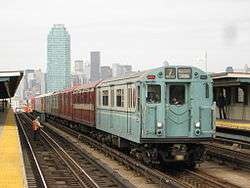R9 (New York City Subway car)
| R9 | |
|---|---|
|
| |
| In service | 1940 – 1977 |
| Manufacturer | American Car and Foundry (?), Pressed Steel Car Company (?) |
| Built at | Chicago, Illinois, USA |
| Replaced | Additional fleet for the IND Sixth Avenue Line and 3 additional cars replacing cars in a 1936 accident |
| Constructed | 1940 |
| Entered service | 1940 |
| Number built | 153 |
| Number preserved | 3 |
| Number scrapped | 150 |
| Fleet numbers | 1650-1802 (motorized single units) |
| Capacity | 56 (seated) |
| Operator(s) | New York City Subway |
| Specifications | |
| Car body construction | Riveted steel |
| Car length | 60 feet 2 1⁄2 inches (18.35 m) |
| Width | 10 feet (3.05 m) |
| Height | 12 feet 1 5⁄8 inches (3.70 m) |
| Platform height | 3.76 ft (1.15 m) |
| Doors | 8 |
| Maximum speed | 55 mph (89 km/h) |
| Weight | ~ 84,575.5 lb (38,362.8 kg) |
| Traction system | Westinghouse 570-D5 or General Electric 714-D4, 714-D5 |
| Power output | 190 hp (142 kW). |
| Electric system(s) | 600 V DC Third rail |
| Current collection method | Contact shoe |
| Braking system(s) | WABCO Schedule AMUE with UE-5 universal valve, ME-23 brake stand, and simplex clasp brake rigging. WABCO D-3-F air compressor |
| Coupling system | WABCO H2A |
| Headlight type | incandescent light bulbs |
| Track gauge | 4 ft 8 1⁄2 in (1,435 mm) |
The R9 was a New York City Subway car which was built in 1940 for the IND and its successors, which included the New York City Board of Transportation and the New York City Transit Authority. A total of 153 R9 (or "Arnine") cars were ordered from two different manufacturers. Cars 1650-1701 were built by American Car and Foundry, while cars 1702-1802 were built by Pressed Steel. 150 of the new cars were ordered for service on the new IND Sixth Avenue Line, which opened on December 15, 1940. The Sixth Avenue Line was the second IND Manhattan trunk line (joining the 1932 IND Eighth Avenue Line), and therefore the additional cars were needed for the new service. The remaining 3 cars in the R9 contract were ordered as replacements for 3 older IND cars (cars #212, #378, and #472) that had been damaged beyond repair as a result of a February 17, 1936 collision at the Smith–Ninth Street station.[1]
The 153 R9 cars remained the newest part of the IND fleet until the arrival of the R10 cars in 1948. The R9s were also used for service on the IND exclusively until 1968, when they were displaced by the new R40 cars, and were transferred to the East New York Yard of the Eastern Division, and were used on the former BMT J, KK, LL, M, and QJ routes until 1977 when the R9s were retired, and replaced by the R46s.
Retirement and after service life
The fleet of R9 cars stayed intact and in service until being retired from service in 1976 and 1977. The last day of R9 cars in service was on March 31, 1977 as the cars made their final run on the J train.
Following their retirement, the majority of the cars were scrapped. However, three have been preserved.
- Car 1689 has been preserved by the Shore Line Trolley Museum in East Haven, Connecticut and has been restored
- Car 1801 has been preserved by the New York State Museum in Albany, New York
- Car 1802 has been preserved by Railway Preservation Corp. and has been restored
Further reading
- Sansone, Gene. Evolution of New York City subways: An illustrated history of New York City's transit cars, 1867-1997. New York Transit Museum Press, New York, 1997 ISBN 978-0-9637492-8-4
External links
References
- ↑ Cunningham, Joseph; DeHart, Leonard O. (1993-01-01). A History of the New York City Subway System. J. Schmidt, R. Giglio, and K. Lang.


